The Micro Balances Market is estimated to be valued at USD 890.0 million in 2025 and is projected to reach USD 1549.3 million by 2035, registering a compound annual growth rate (CAGR) of 5.7% over the forecast period.
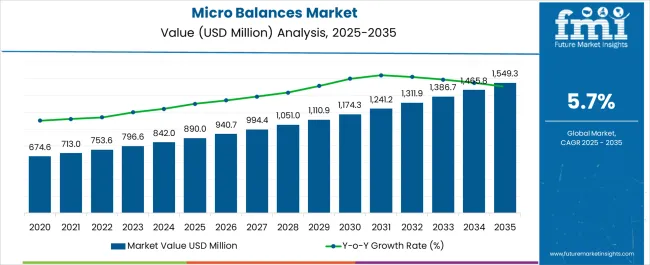
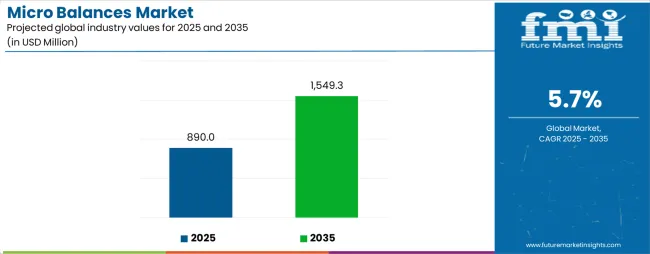
| Metric | Value |
|---|---|
| Micro Balances Market Estimated Value in (2025 E) | USD 890.0 million |
| Micro Balances Market Forecast Value in (2035 F) | USD 1549.3 million |
| Forecast CAGR (2025 to 2035) | 5.7% |
The Micro Balances market is witnessing steady growth, driven by increasing demand for precise measurement solutions across laboratory, pharmaceutical, and chemical sectors. The market is shaped by growing requirements for accuracy, repeatability, and reliability in weighing minute quantities for research, quality control, and industrial testing applications. Technological advancements in microbalances, including enhanced sensitivity, digital integration, and automated calibration, are further strengthening their adoption.
Rising investment in pharmaceutical research, chemical testing, and laboratory automation is driving the need for high-precision analytical equipment. The market outlook remains positive, as regulatory compliance, stringent quality standards, and increasing laboratory infrastructure in emerging economies are expected to expand demand.
Continued innovation in microbalance technology, particularly in features such as environmental compensation, connectivity with data management systems, and compact design, is anticipated to create new growth avenues With laboratories seeking efficiency and accuracy simultaneously, microbalances are positioned as indispensable instruments that provide actionable, reliable measurements essential for both research and industrial applications.
The micro balances market is segmented by equipment type, testing samples, end use, and geographic regions. By equipment type, micro balances market is divided into Micro Analytical Balances, Semi Micro Balances, and Ultra Micro Balances. In terms of testing samples, micro balances market is classified into Chemicals, Tissues, Powder, and Volatile Substances. Based on end use, micro balances market is segmented into Pharmaceutical Industries, Chemical Industries, Healthcare & Life Sciences, Research And Development Centers, Educational Institutes, and Government Agencies. Regionally, the micro balances industry is classified into North America, Latin America, Western Europe, Eastern Europe, Balkan & Baltic Countries, Russia & Belarus, Central Asia, East Asia, South Asia & Pacific, and the Middle East & Africa.
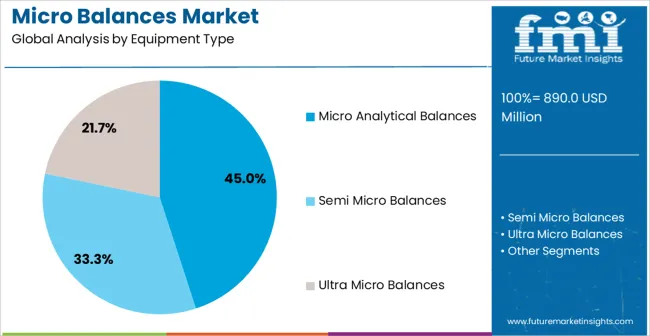
The Micro Analytical Balances equipment type is expected to hold 45.0% of the market revenue share in 2025, positioning it as the leading segment. The growth of this segment is driven by the ability of these balances to provide highly precise and reproducible measurements, essential for laboratories conducting sensitive experiments or formulations. Adoption has been accelerated by the increasing integration of digital interfaces, automated calibration, and high-stability designs that reduce measurement errors caused by environmental factors.
Micro Analytical Balances are preferred in applications requiring stringent quality control and compliance with laboratory standards. Their capability to handle extremely small sample sizes without compromising accuracy has reinforced their market position.
In addition, the ongoing trend of laboratory automation and the adoption of smart data logging systems have contributed to the segment’s prominence The high reliability, adaptability to diverse laboratory conditions, and ability to integrate with modern data systems are expected to sustain continued growth for micro analytical balances.
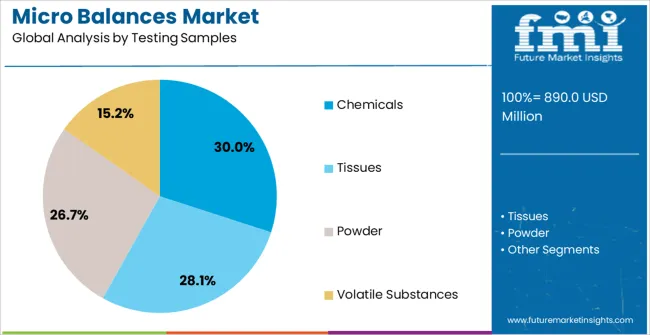
The Chemicals testing sample segment is projected to hold 30.0% of the Micro Balances market revenue share in 2025, emerging as the leading sample category. This dominance is being influenced by the increasing use of microbalances in chemical laboratories for precise weighing of reagents, solvents, and compounds where accuracy is critical for experiment reproducibility. The growth is further supported by stringent regulatory requirements for chemical formulation, testing, and quality assurance.
The need for highly sensitive instruments capable of detecting minute variations in chemical samples has made microbalances indispensable in this segment. The adoption of microbalances is also being encouraged by the rising focus on chemical research, environmental testing, and analytical chemistry applications that demand precise quantification.
Their robustness, combined with the ability to integrate with digital data systems for recordkeeping and traceability, has reinforced the market share of chemical applications The continuous innovation in microbalance technology ensures that the chemicals segment will remain a key contributor to overall market growth.
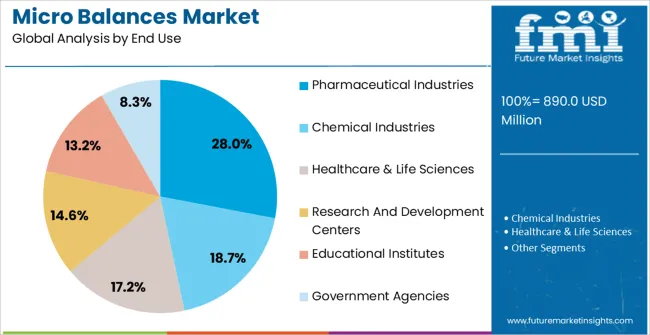
The Pharmaceutical Industries end-use segment is expected to account for 28.0% of the Micro Balances market revenue share in 2025, making it the leading end-use category. The growth of this segment is primarily driven by the critical need for precise measurement of active pharmaceutical ingredients and excipients during drug formulation, quality control, and research and development processes. Microbalances provide accurate measurements that are essential for compliance with regulatory standards, ensuring consistency and safety of pharmaceutical products.
Increasing investments in drug development, expansion of pharmaceutical manufacturing units, and adoption of laboratory automation are further contributing to segment growth. The integration of microbalances with digital recordkeeping and data management systems has enabled enhanced operational efficiency and traceability.
Additionally, the growing emphasis on miniaturized testing, high-throughput analysis, and the development of complex formulations has reinforced the demand for microbalances within pharmaceutical applications These factors collectively support the continued leadership of the Pharmaceutical Industries segment in the Micro Balances market.
Micro Balances are high-performance instruments which are capable of measuring accurate and precise readings of small masses of million parts of the gram. Micro balances are extremely sensitive balances that can determine weight of delicate and minute objects.
Also, these are gaining traction in the market as these are fast and provide precise results as compared to other balances and scales available in the market. These are used for determination of weight of powder, volatile chemicals, tissues, and delicate substances.
Micro Balances play a significant role in clinical research. Minor variation in weight can cause a big difference. For ensuring that the product is meeting the desired standards, the micro balances are used in quality assurance laboratories, and product testing departments.
Due to increasing demand for advanced micro balances, the manufacturers of the laboratory balances are continuously concentrating on upgrading the least count, resolution, and the speed of the micro balances.
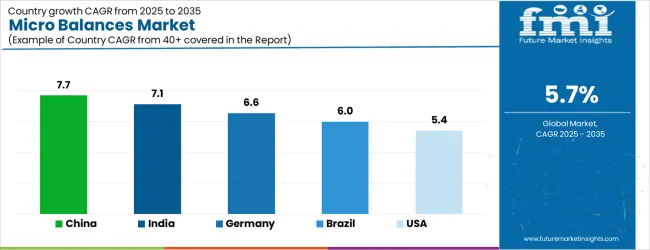
| Country | CAGR |
|---|---|
| China | 7.7% |
| India | 7.1% |
| Germany | 6.6% |
| Brazil | 6.0% |
| USA | 5.4% |
| UK | 4.8% |
| Japan | 4.3% |
The Micro Balances Market is expected to register a CAGR of 5.7% during the forecast period, exhibiting varied country level momentum. China leads with the highest CAGR of 7.7%, followed by India at 7.1%. Developed markets such as Germany, France, and the UK continue to expand steadily, while the USA is likely to grow at consistent rates. Japan posts the lowest CAGR at 4.3%, yet still underscores a broadly positive trajectory for the global Micro Balances Market.
In 2024, Germany held a dominant revenue in the Western Europe market and is expected to grow with a CAGR of 6.6%. The USA Micro Balances Market is estimated to be valued at USD 324.7 million in 2025 and is anticipated to reach a valuation of USD 324.7 million by 2035. Sales are projected to rise at a CAGR of 0.0% over the forecast period between 2025 and 2035. While Japan and South Korea markets are estimated to be valued at USD 41.4 million and USD 30.6 million respectively in 2025.
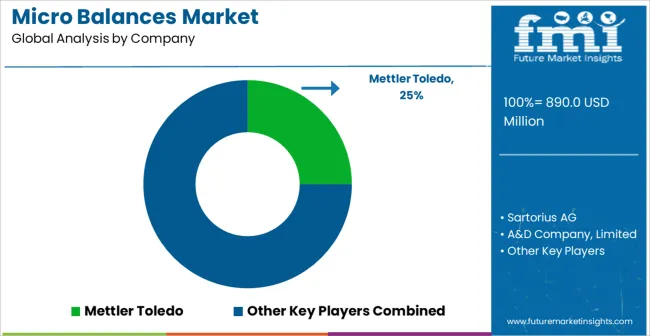
| Item | Value |
|---|---|
| Quantitative Units | USD 890.0 Million |
| Equipment Type | Micro Analytical Balances, Semi Micro Balances, and Ultra Micro Balances |
| Testing Samples | Chemicals, Tissues, Powder, and Volatile Substances |
| End Use | Pharmaceutical Industries, Chemical Industries, Healthcare & Life Sciences, Research And Development Centers, Educational Institutes, and Government Agencies |
| Regions Covered | North America, Europe, Asia-Pacific, Latin America, Middle East & Africa |
| Country Covered | United States, Canada, Germany, France, United Kingdom, China, Japan, India, Brazil, South Africa |
| Key Companies Profiled | Mettler Toledo, Sartorius AG, A&D Company, Limited, Shimadzu Corporation, Radwag Balances and Scales, Precisa Gravimetrics AG, Citizen Scales, and Adam Equipment |
The global micro balances market is estimated to be valued at USD 890.0 million in 2025.
The market size for the micro balances market is projected to reach USD 1,549.3 million by 2035.
The micro balances market is expected to grow at a 5.7% CAGR between 2025 and 2035.
The key product types in micro balances market are micro analytical balances, semi micro balances and ultra micro balances.
In terms of testing samples, chemicals segment to command 30.0% share in the micro balances market in 2025.






Our Research Products

The "Full Research Suite" delivers actionable market intel, deep dives on markets or technologies, so clients act faster, cut risk, and unlock growth.

The Leaderboard benchmarks and ranks top vendors, classifying them as Established Leaders, Leading Challengers, or Disruptors & Challengers.

Locates where complements amplify value and substitutes erode it, forecasting net impact by horizon

We deliver granular, decision-grade intel: market sizing, 5-year forecasts, pricing, adoption, usage, revenue, and operational KPIs—plus competitor tracking, regulation, and value chains—across 60 countries broadly.

Spot the shifts before they hit your P&L. We track inflection points, adoption curves, pricing moves, and ecosystem plays to show where demand is heading, why it is changing, and what to do next across high-growth markets and disruptive tech

Real-time reads of user behavior. We track shifting priorities, perceptions of today’s and next-gen services, and provider experience, then pace how fast tech moves from trial to adoption, blending buyer, consumer, and channel inputs with social signals (#WhySwitch, #UX).

Partner with our analyst team to build a custom report designed around your business priorities. From analysing market trends to assessing competitors or crafting bespoke datasets, we tailor insights to your needs.
Supplier Intelligence
Discovery & Profiling
Capacity & Footprint
Performance & Risk
Compliance & Governance
Commercial Readiness
Who Supplies Whom
Scorecards & Shortlists
Playbooks & Docs
Category Intelligence
Definition & Scope
Demand & Use Cases
Cost Drivers
Market Structure
Supply Chain Map
Trade & Policy
Operating Norms
Deliverables
Buyer Intelligence
Account Basics
Spend & Scope
Procurement Model
Vendor Requirements
Terms & Policies
Entry Strategy
Pain Points & Triggers
Outputs
Pricing Analysis
Benchmarks
Trends
Should-Cost
Indexation
Landed Cost
Commercial Terms
Deliverables
Brand Analysis
Positioning & Value Prop
Share & Presence
Customer Evidence
Go-to-Market
Digital & Reputation
Compliance & Trust
KPIs & Gaps
Outputs
Full Research Suite comprises of:
Market outlook & trends analysis
Interviews & case studies
Strategic recommendations
Vendor profiles & capabilities analysis
5-year forecasts
8 regions and 60+ country-level data splits
Market segment data splits
12 months of continuous data updates
DELIVERED AS:
PDF EXCEL ONLINE
Micro-Vent Cap Systems Market Analysis - Size and Share Forecast Outlook 2025 to 2035
Microfilm Readers and Scanners Market Size and Share Forecast Outlook 2025 to 2035
Micron CBN Powder Market Size and Share Forecast Outlook 2025 to 2035
Microfilm Reader Market Size and Share Forecast Outlook 2025 to 2035
Micro-Dosing Sachet Fillers Market Analysis - Size and Share Forecast Outlook 2025 to 2035
Microbial Growth Monitoring System Market Size and Share Forecast Outlook 2025 to 2035
Micro Hotel Market Forecast and Outlook 2025 to 2035
Microwave Source Market Size and Share Forecast Outlook 2025 to 2035
Micro-energy Harvesting System Market Size and Share Forecast Outlook 2025 to 2035
Micro CHP Market Size and Share Forecast Outlook 2025 to 2035
Micro Irrigation System Market Size and Share Forecast Outlook 2025 to 2035
Micro Flute Paper Market Size and Share Forecast Outlook 2025 to 2035
Microcrystalline Cellulose Market Size and Share Forecast Outlook 2025 to 2035
Micro Perforated Films Packaging Market Size and Share Forecast Outlook 2025 to 2035
Microbial Coagulants Market Size and Share Forecast Outlook 2025 to 2035
Microserver IC Market Size and Share Forecast Outlook 2025 to 2035
Microplate Handling Instruments Market Size and Share Forecast Outlook 2025 to 2035
Microsclerotherapy Treatment Market Size and Share Forecast Outlook 2025 to 2035
MicroLED Photoluminescence Inspection System Market Size and Share Forecast Outlook 2025 to 2035
Micro-Scale VFFS Modules Market Analysis - Size and Share Forecast Outlook 2025 to 2035

Thank you!
You will receive an email from our Business Development Manager. Please be sure to check your SPAM/JUNK folder too.
Chat With
MaRIA